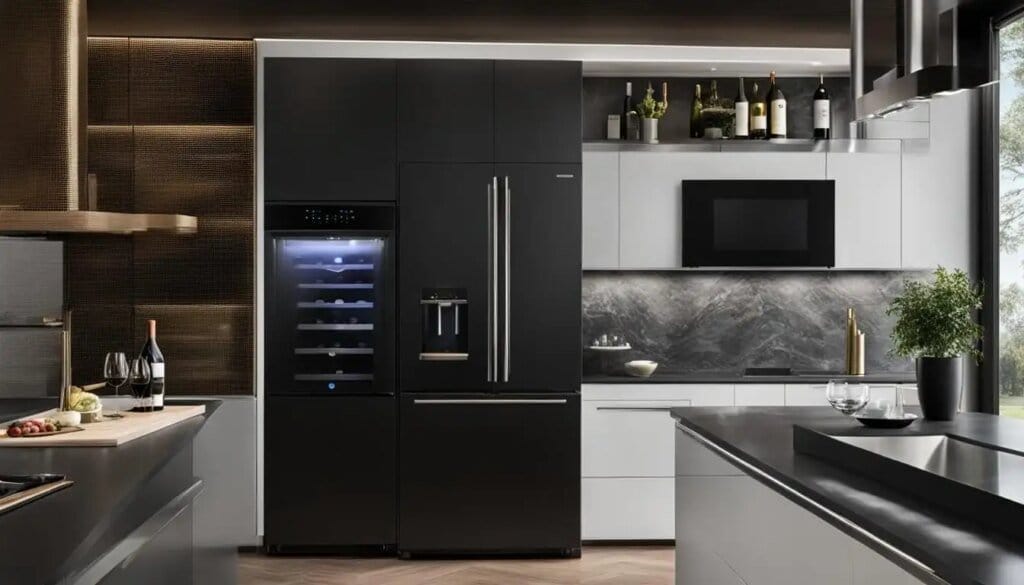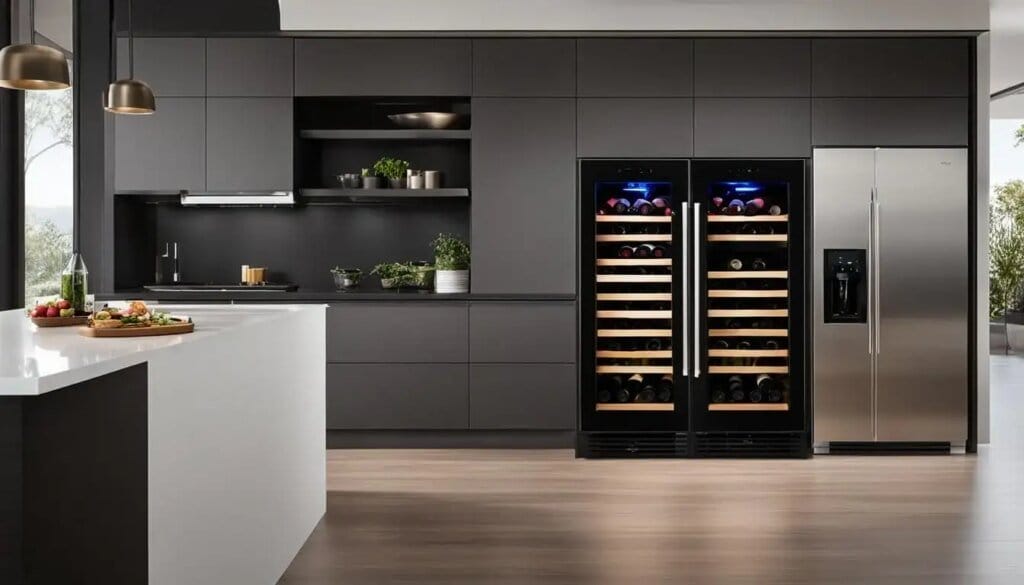If you’re reading this, chances are you’ve encountered the pesky problem of ice build up in your beloved wine fridge. This post will guide you through the process of defrosting your wine fridge safely and effectively.
Ice build up in a wine fridge can be caused by various factors such as frequent door openings, improper insulation, high humidity levels, and exceeding the fridge’s capacity. Not only can this ice harm your precious wine collection, but it can also affect the flavor and promote the growth of bacteria and mold. It’s time for defrosting your wine fridge.
Before we proceed, let me assure you that you don’t need any fancy tools or special skills to defrost your wine fridge. All you need is a bit of patience and some basic knowledge. So, let’s get started!
Key Takeaways:
- Ice build up in a wine fridge can be caused by multiple factors, including frequent door openings and high humidity levels.
- Ice build up can harm your wine collection, alter the flavor, and promote the growth of bacteria and mold.
- Defrosting a wine fridge involves simple steps such as unplugging the fridge, removing all bottles, and removing the ice and water with a towel.
- Regular maintenance, such as cleaning the fridge, checking the temperature, and adjusting the humidity levels, can help prevent ice build up.
- By following proper defrosting techniques and maintenance practices, you can ensure the longevity of your wine fridge and the quality of your wine.

Common Causes Of Ice Build Up In A Wine Fridge
Ice build up in a wine fridge can be caused by several factors. Understanding the causes can help you prevent this common issue and ensure the optimal performance of your wine fridge.
1. Opening & Closing The Door Too Often
- One of the primary causes of ice build up in a wine fridge is frequently opening and closing the door.
- Every time the door is opened, warm air from the surrounding environment enters the fridge.
- This warm air condenses on the cold surfaces inside the fridge, leading to ice formation.
2. Improper Insulation
- Inadequate insulation in a wine fridge can result in ice build up.
- When insulation is compromised, cold air may escape from the fridge while warm air from outside seeps in.
- This temperature difference leads to condensation and ice formation.
3. High Humidity Levels
- Elevated humidity levels inside a wine fridge can contribute to ice build up.
- Excess moisture in the air condenses on the cold surfaces of the fridge, forming ice.
- This can occur if the humidity control settings are not properly adjusted or if the fridge is located in a humid environment.
4. Exceeding The Fridge’s Capacity
- Overfilling a wine fridge beyond its intended capacity can prevent the door from closing properly.
- When the door doesn’t seal tightly, warm air enters the fridge, causing ice build up.
- It is essential to follow the manufacturer’s guidelines and not exceed the recommended bottle capacity.
The Harmful Effects Of Ice Build Up
Ice build up in a wine fridge can have serious consequences for both your wine collection and the fridge itself.
1. Cause The Dropped Temperature
- The accumulation of ice can cause the temperature inside the fridge to drop significantly and the humidity levels to rise.
- This creates an environment that is not suitable for wine storage and can lead to various harmful effects.
2. Promote The Mold & Bacterial Growth
- One of the main risks of ice build up is the promotion of bacterial growth, mold, and mildew.
- The moisture from the ice provides a breeding ground for these microorganisms, which can contaminate your wine bottles and compromise their quality.
- The presence of bacteria, mold, and mildew can result in irreversible damage to the wine, altering its flavor and making it undrinkable.
3. Damage The Fridge
Ice build up can also damage the wine bottles and the wine cooler.
- The excessive ice formation can put strain on the internal components, such as the cooling system and the compressor.
- This can lead to increased energy consumption, reduced efficiency, and ultimately, the breakdown of the fridge.
- As the ice expands, it can put pressure on the glass, make the bottles more fragile, causing them to crack or shatter.
- This not only results in the loss of valuable wine but also poses a safety risk in terms of broken glass and potential injury.
To prevent these harmful effects, prioritize the proper maintenance of your wine fridge. Regularly checking the temperature and humidity levels, cleaning the interior, and defrosting when necessary are crucial steps to avoid ice build up. By taking these precautions, you can preserve the quality of your wine collection and extend the lifespan of your wine fridge.

Defrost A Wine Fridge Steps
By following these steps, you can effectively defrost your wine cooler and maintain its optimal performance for the long term.
- Unplug the fridge: Start by disconnecting the power source to prevent any electrical accidents during the defrosting process.
- Remove all bottles: Take out all the bottles stored in the fridge and place them in a cool and safe location. This step will allow you to have easy access to the interior of the fridge.
- Check the temperature: Before starting the defrosting process, make sure that the fridge is not too cold. A slightly higher temperature will help facilitate the melting of any ice or frost inside.
- Empty the fridge: Once you’ve confirmed the temperature, remove all remaining contents such as racks, shelves, and drawers. This will ensure a thorough defrosting and prevent any damage to the components.
- Remove ice, frost, and water: With a soft towel or sponge, carefully start removing the ice build up, frost, and any water that has accumulated inside the fridge. Be gentle to avoid damaging the fridge or its electrical components.
- Clean and dry the interior: Once the defrosting is complete, clean the interior of the fridge. Use soap and water to wipe down all surfaces, removing any remaining residue. Rinse away the soap and ensure that the interior is completely dry before proceeding.
- Turn the fridge back on: After the cleaning process, you can now plug the fridge back into the power source and switch it on. Make sure to set the temperature to the desired level for wine storage.
- Return bottles to the fridge: Once the fridge is running again, carefully place the bottles back inside, ensuring they are stored properly and securely.
Tips For Maintaining A Wine Cooler
Maintaining a wine fridge is essential for preserving the quality of your wine and ensuring its optimal taste and aroma. Follow these expert tips to keep your wine fridge in top shape:
- Regular Cleaning: Wipe down the interior and exterior of the wine fridge regularly to remove dust, dirt, and any spills. A clean fridge prevents unpleasant odors and maintains a sanitary environment for your wine collection. Do this at least twice a year.
- Temperature Control: Check the temperature settings of your wine fridge to ensure it is appropriately set for wine storage. The ideal temperature range for most wines is between 45°F and 55°F. Fluctuations in temperature can adversely affect the quality of the wine.
- Secure Door Closure: Keep the door of your wine fridge closed as much as possible to minimize temperature fluctuations. The constant opening and closing of the door can disrupt the internal temperature, potentially damaging your wine.
- Carbon Filter Replacement: Replace the carbon filter in your wine fridge regularly to prevent any unwanted odors from affecting the flavor of your wine. This simple maintenance step ensures that your wine retains its intended aroma and taste.
- Humidity Adjustment: Maintain the recommended humidity levels within your wine fridge to prevent the corks from drying out or becoming too moist. The ideal humidity range for wine storage is typically around 60-70%.
- Vibration Monitoring: Minimize vibration around your wine fridge as excessive movement can disturb the sediments in the wine, leading to reduced clarity and taste. Ensure your wine fridge is placed on a stable surface and away from any source of vibration.
- Air Circulation: Periodically open the door of your wine fridge to let in fresh air and prevent mold and mildew growth. This practice helps maintain proper air circulation and prevents any musty smells from developing.
Bottom Line
Defrosting a wine fridge is a vital step in maintaining its optimal performance and ensuring the longevity of your appliance. Ice build up in a wine fridge can have detrimental effects on both the wine and the fridge itself.
By following the recommended tips for defrosting and maintaining a wine fridge, you can prevent ice build up, safeguard your wine collection, and enjoy your favorite bottles in perfect conditions.
Incorporating regular defrosting and following the proper maintenance techniques, you can protect your wines from bacterial growth, mold, and mildew, as well as preserve their flavor and quality. With a well-maintained wine fridge, you can continue to savor your collection, knowing that each bottle is being stored in the best possible conditions.
Happy cooling!
FoodiesFridge









